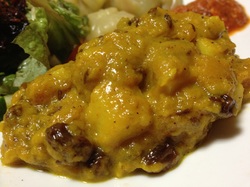 It's awhile since I've been truly wowed by my own cooking. I like to think I make tasty food but honestly it's the process of cooking that interests me - the chopping of vegetables, mixing and spices and stirring of sauces is my own personal therapy. It keeps me calm and focused and helps me work through periods of stress. For me, the final result is something of an after thought - obviously it's important since how I want something to taste influences the steps I take while cooking but I rarely cook when I'm starving - since cooking, for me, is a lengthy process I make a quick and basic meal when I simply want to satiate my hunger.
This past weekend I decided to try my hand at pumpkin curry. I make a rather tasty pumpkin soup for which I roast pumpkin (or squash) with butter, cinnamon and brown sugar in my toaster oven before adding it to sauteed onions and carrots. After adding a few additional spices the end result is pureed and blended with coconut milk. Since I was already using a variety of spices found in curry I thought perhaps I could adjust the soup and make a flavorful curry with pumpkin. I searched the internet for recipes and decided to use this one as a base. However, it was more Thai than Indian so I made a lot of alterations. The end result was a deliciously creamy sweet and spicy curry that was hearty and filling. After taking the first bite I exclaimed "oh, that's good!" and I think my friend who was joining me for supper agreed because she had seconds. Below is my recipe for pumpkin curry. Ingredients 3-4 cups of pumpkin or acorn squash peeled and cut into 1/2 inch cubes 1-2 cups of sweet potato peeled and cut into 1/2 inch cubes 1 onion finely diced or grated 4 garlic cloves finely diced or crushed using a garlic press 1 in. ginger grated or crushed using a garlic press 1 red pepper cut into 1/2 in. pieces 1/2 can of coconut milk 1-2 T of vegetable or sesame oil 1-2 t of vegetable or sesame oil 1 T garam masala 1 T turmeric A pinch of chili pepper powder Salt and pepper to taste Tadka 1 T ghee 1/2 T cumin seeds 1 t cinnamon powder A pinch of nutmeg powder A pinch of hing (asofetida) Peel and cut the pumpkin and sweet potato into approximately 1/2 inch cubes and set aside. Finely dice or grate the onion and set aside. Cut the red pepper into 1/2 inch pieces and set aside. Heat 1-2 T of vegetable or sesame oil in a frying pan. When the oil is hot add the onions and slightly salt, this will help remove the moisture. When the onions are beginning to soften and starting to become translucent add the garlic and ginger and cook it for a few minutes. The onions should be translucent and the garlic and ginger aromatic. Move the garlic/ginger/onion mixture to the outer edges of the pan and add a small amount of oil and heat up. Next add the garam masala and turmeric powder. You can add a small bit of water to the powders first in order to make a paste - this will keep them from burning. Stir the spices into the oil to keep them from burning and cook for a minute. Mix the spices into the onion mixture. Add the pumpkin and sweet potato - blend it into the onion mixture and sautee the vegetables for a few minutes stirring occasionally to keep it from burning. Add 1 cup of water and bring it to a boil then lower the heat and let the vegetables cook. When the pumpkin and sweet potato are almost thoroughly cooked add 1/2 can of coconut milk and chili powder to taste. Meanwhile add some water to the raisins in a microwave safe dish and heat them for 30 seconds. This will help plump up the raisins. Drain the water and add the raisins to the curry while it simmers. Keep the curry on a low flame to simmer so the flavors blend together. Stir it occasionally and salt and pepper to taste. While the curry simmers heat the ghee in a separate pan for the tadka. When it is hot add the cumin seeds, cinnamon powder, nutmeg and hing and heat them until the cumin crackles. Add the tadka to the curry and stir in the spices. This curry serves approximately 4 and can be served with a long-grained rice like Basmati or flat bread (rothi is the healthiest option). You can make adjustments to the recipe to fit your taste - I think slices of almonds and cashews would add a nice crunch to the curry. Bright green or red vegetables will create a more artistic presentation of the curry. You can also adjust the spices to your own taste - fe
0 Comments
I've been in a cooking slump for awhile and have been struggling to get out of it. Naturally as a vegetarian in Korea that doesn't mean I've stopped cooking altogether - no, instead I've just been incredibly lazy or bored with what I've been cooking. I've been making grilled peanut butter sandwiches (YUM) more frequently and the same one or two curries - or variations of them over and over. It's felt like months since I tried out a new recipe even though I've been desperately looking for a food inspiration everywhere.
Sometimes that inspiration pops up in weird places - a friend's off-hand comment on Facebook about his co-workers complimenting his chopstick skills led to a reply about mapo tofu. Suddenly I knew what I was going to have for dinner and stopped by the local shop for some soft tofu for the dish. Other times the inspiration has been there for months but it's been pushed to the back of my mind and needed a way to re-assert itself in my sub-consciousness. That's what happened with momos. Months ago a friend visited and we got onto the discussion of Nepali food - she loved momos. Years ago a couple of Nepalis I knew had made those dumplings for me and so when Youl mentioned them I remembered those flavorful steamed buns and the accompanying spicy sauce and decided then and there try my hand at them. I promptly went out and bought a steamer and began to research recipes. Somewhere something happened - most likely I went through one of my phases were the idea of cooking in my miniscule kitchen infuriated me - and the determination faded and eventually the idea of making momos had found itself buried amidst all the other things at one time I had committed myself to doing. However recently I've been making plans with Youl to meet up and the idea of making momos crept back up from the recesses of my mind into the forefront. Since our last meeting I had moved to a substantially larger apartment - one with a large counter top and three (THREE!) burners. My fridge wasn't the kind that you might find in a dormitory but almost - but not quite - a "normal" sized fridge like you might find in a house in the United States. While lazily relaxing Saturday afternoon and eating yet another meal of left over curry I decided that I would spend the following day making momo. I headed to the store the next morning stocking up on milk and scallions and came home ready to cook. As a momo making novice I found my first foray into making the dumplings to be a bit time consuming. Before even attempting to make the actual dumpling filling and wrappers I had to make the achar - the spicy accompanying sauce in addition to the paneer which I would add to the filling. I spent an hour or two charring tomatoes, dry roasting and grinding spices and making paneer. Finally after securing the top on the container with the achar while the paneer drained I began to prep the vegetables and spices for the momo. I spent a lot of time reading through recipes for vegetarian momos and I finally decided upon this recipe. The ingredients sounded closest to what I remember the Nepalis using and so I started to prep everything. The process was also explained well which gave me some confidence. However, I found the spices to be a bit uninspiring and so I found a recipe which called for a 1/4 teaspoon of a spice mixture of dry roasted and ground equal parts of fennel, cumin, mustard seeds, fenugreek and sesame seeds. Once I had the mixture prepared I started on the wrappers and finally - hours after I started I was assembling momo and heating the water in the steamer. Overall the momo were good - when I make them again in the future I'll add more spices because I feel like the flavor of the momo gets lost once you dip it in the achar (which is delicious due to the roasting of the tomatoes). I'll also have to make sure I add more flour and roll the wrappers a bit more thin because the dumplings were slightly tacky when I took them out of the steamer which wasn't how I remembered my first momo experience. Below are a couple of pictures from my momo experiment. The picture on the left is the momo and achar (with baigan aloo and cucumbers in the background). The picture on the right is my Indian "grilled cheese and tomato" - peanut rothi stuffed with the momo mixture and grilled with the roasted tomato achar and Andhra tomato pickle (with yogurt and cucumber in the background).  I've been trying to find different ways to get protein instead of relying so heavily on tofu and dairy. Though I love to try new foods and discover unfamiliar cuisines sometimes I miss the basics from back home. Though I've never been a big burger fan (not surprising since I ended up a vegetarian) I do occasionally enjoy a patty piled high with tasty toppings on a bun. Kuma's in Chicago has, hands-down, the most delicious veggie burgers and fixin's I've ever had. Their high on fire burger is one of the most delicious things I've ever eaten - an incredible balance of sweet (pineapple) and spicy (sriracha and sweet chili paste) served atop a pretzel bun. There are a few things I try to ensure I do every time I'm back in the city - spend some time in Millennium Park, wander around Devon, gorge on cupcakes at Molly's and, of course, enjoy a burger and beer at Kuma's. I feel somewhat cheated if I don't get the chance to stop in for a meal. And from what I hear they have a pretty tasty beef burger as well ^^
Since I've been a bit bored with the constant curry and tofu that I've been consuming over the past several months I decided to try my hand at a veggie burger. However, as I scoured the internet for a decent recipe I can upon an unexpected problem - most veggie burger recipes call for egg. Years ago this wouldn't have been a problem but when I started my research at the temple I made the conscious decision to cut back on egg which isn't considered vegetarian by most Hindus. I still eat some things with egg in the ingredients like bread and ice cream. Also if I'm absolutely desperate for protein while traveling I might consume egg but overall I try to avoid it and I don't keep egg in my home. Finally after a few days of research I stumbled upon this great vegan recipe for veggie lentil burgers. I was thrilled to see it was a recipe by Alton Brown and with a little additional time searching the web I found the corresponding Good Eats episode. I was thoroughly entertained while Alton expounded upon the usefulness of lentils in his usual silly and self-effacing manner and learned a bit more about lentils and how to make this recipe. I've made the burgers a couple of times and they're relatively easy to make and pretty tasty. You won't confuse them with a beef burger but they're incredibly nutritious with plenty of protein and taste delicious with all the burger toppings you can think of (I'm partial to tomato pickle). 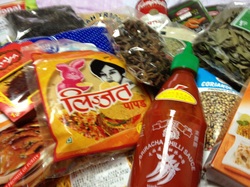 While I am still surprised by some of the items I can find at the local Home Plus there are a multitude of dried goods, herbs and other things that are unavailable in Jeomchon or the surrounding area. That's why when I visit Seoul I try to stop by the International Market in Itaewon. This recently expanded store offers a variety of international food products and toiletries and even has a small section with cell phones. The store has a wide selection of products with many that are staples and others which vary depending on what the owner can order. It seems the food at the market can be divided into three categories - the subcontinent (Indian, et al), South East Asian and Western. Prices are reasonable - obviously they're going to be more expensive than back home because most things are imported but I've never thought anything there was outrageously priced. Before I came to Korea I packed half of one suitcase with different spices with which to cook my curries - I realize now that I could have bought pretty much everything at this store. Here's a brief run down of some of the items I've seen at the store - this is just a small sampling. On my next visit I'll try to take note of other items so I can add to the list. Western - Kraft macaroni and cheese, varieties of Campbell soups (including tomato), dried pasta, cheese (cheddar, gouda, etc), cookies, candy, Ritz crackers, tabasco sauce, taco seasoning, tortilla chips, peanut butter, a variety of canned vegetables, etc. On my last visit (5/19/12) I saw root beer (!) South East Asian - fish sauce, rice paper, frozen lemon grass, tamarind, basmati rice, sriracha, etc. Subcontinent - lentils (chana dal, urad dal, moong dal, etc), spices (jeera, cardamom, turmeric, etc) and masalas, atta, basmati rice, RTD (ready to eat packets), papads, homemade yogurt, hing, saffron, etc There is a *small* produce section which has a few varieties of fresh vegetables and herbs such as mint, cilantro and basil. Toiletries - some Western shampoos and deodorants, henna for hair conditioning/coloring and coconut oil. Foreign Food Market - Directions  I don't know the address of this market but the directions there are relatively simple.
Take the brown line (line 6) to Itaewon (이태왼). Exit the station using exit 3, continue walking east along the main road (you should be walking away from Subway and KFC). When you come to the fire station (119), a two story building set back from the road, turn right. Continue walking up the small hill past the Foreign Food restaurant and a night club and you will see the Foreign Food Market on the left. The star on the map is an estimate but should you an approximate idea of where the store is located. The staff speaks English. 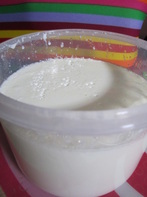 Living in Korea as a vegetarian has presented some challenges that I didn't experience when I lived in Spain and Japan because I ate meat. I ate Spanish and Japanese food everyday, in retrospect, with relative ease since my only dietary restriction was a life long distaste for seafood.
Being a vegetarian in the USA is relatively easy because 1) I speak the language and can communicate clearly with waitstaff, grocery clerks and others and 2) In the past 8 years I have lived in or near relatively diverse areas and so I have always had access to ethnic grocery stores and 3) I enjoy cooking and frequently made meals at home. Being a veggie in Korea is slightly more difficult because I can't communicate with people (and even if I could I realize there's a lot "hidden" fish sauce in food) and I don't have access to the same items back home. While I have easy access to fresh vegetables, common ingredients in my diet back home are rare or even non-existent in Korea. About once a week I supplemented my protein intake with faux meat options and only had to stop at an Indian grocery store to stock up on chickpeas, lentils and frozen flat breads like roti and paratha. I've had hard luck finding those things in the Jeomchon area and so when I make plans to visit a large city like Daegu or Seoul I incorporate a stop at an international market. Since moving to Korea though I've noticed that my energy level has dropped and at times I've had difficulty focusing - based on my dietary restrictions and being aware of what I've been eating over the past month I came to the conclusion that I'm not getting enough protein and so I decided to eat more yogurt which is relatively high in protein (yup, I finally got around to the topic of this post - my professors tell me I'm a bit superfluous). When I purchased my first container of it I discovered that much to my dismay yogurt, even plain yogurt, is sweetened and flavored. While it's perfectly tasty and a good snack sweetened yogurt is an awful addition to curries and so I decided to make my own. With the lack of plain yogurt being available I risked making it with the slightly sweetened yogurt. Since homemade yogurt requires active cultures I did a bit of internet research and decided that Dannon's activia yogurt would make the best starter and proceeded from there. What I discovered is that making yogurt is relatively easy (as long as you pay attention to the milk on the burner or you'll burn your first batch like I did) thanks to resources like this step-by-step guide. I attempted my first batch one evening and after initially burning a pan of milk (argh!) I started over again and made it through the entire process and the yogurt was safely stored in the microwave before I went to bed that evening. When I came home from school the following day I expected a sloppy rancid mess but instead found slightly sweetened homemade yogurt. I'm quite excited about the results because it means I finally get to make a grilled paneer dish where one of the main ingredients is yogurt. With this feat accomplished and an upcoming trip to Seoul to see a friend and grocery shop my next experiment will be making roti. 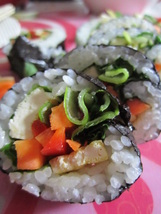 Kimbap, a seaweed wrapped roll of rice filled with a variety of veggies and meat is a popular food in Korea. Many people refer to it as Korean sushi and though it shares many similarities with the Japanese dish but they're not quite the same. The rice used for kimbap is simple steamed rice whereas sushi rice is vinegared (which is what makes a dish sushi contrary to the popular belief that sushi is synonymous with raw fish). Not surprisingly, kimbap in shops is like most other Korean food and meat is incorporated into even seemingly veggie friendly rolls. Another interesting addition to kimbap is mayonnaise. Personally I find the taste and texture of the rice/mayonnaise combination a bit odd and therefore I don't particularly care for the kimbap I've found in shops. However, a trip to a kimbap shop with Kate led me to realize I could easily create a tasty vegetarian kimbap at home. I scoured the internet for a few recipes and tips and then got to work one evening.
As you can see in the pictures below kimbap is relatively easy to make - you need a sheet of seaweed, warm steamed rice and you choice of fillings - I chose to blanch carrots and red peppers and throw them in the kimbap alongside green onions, sesame leaves and sauteed tofu. My first roll was a bit of a disaster because I didn't take into account that spreading the rice to the edge of the seaweed wrapper would keep the seaweed from sealing. However, my second attempt worked out much better and for the most part it stayed together. I was pretty proud of the results and my students were impressed when they saw kimbap in my lunchbox the following day at school. Since making this initial batch of kimbap I've come to the conclusion that the rice becomes a bit dry if not eaten immediately - in order to rectify this problem I know mush up half an avocado and spread it on the rice before adding the remaining ingredients which helped create a more moist kimbap. 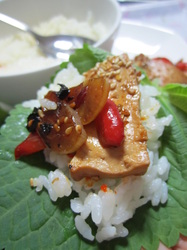 Bulgogi is an incredibly popular dish here in Korea, in fact many of my students say it is their favorite food. Bulgogi is beef which has been marinated in a mixture of soy sauce, sugar, garlic, sesame oil, etc. and then grilled. When my friend Kate mentioned that she made bulgogi at home with sesame oil I instantly became intrigued - I love the flavor of sesame oil and typically add a couple of drops into the rice cooker before steaming rice. I found this basic bulgogi recipe online and substituted tofu for beef but otherwise stayed true to the recipe. Since I had onions and red peppers in the fridge I threw them in the marinade as well for some added nutrients and color. Everything was grilled in a frying pan on the burner. Tired of just rice and vegetables I decided to wrap my veggie bulgogi in sesame leaves with steamed rice and a smear of chili paste.
While the dish had some nice flavors I felt the firm tofu as I prepared it wasn't a good substitute for beef. In the future I'll pan-cook the tofu which will remove a lot of the excess moisture and then I'll marinate the tofu in the soy sauce and other ingredients. 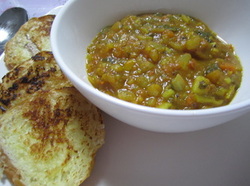 Since I don't eat out very often here in Korea I've taken to cooking regularly again. I stopped cooking, for the most part, in June when I became extremely busy with my thesis research and job. I found that I was too exhausted each evening when I got home after 9 to make a real meal and instead became extremely reliant on instant oatmeal, pre-made faux meat and other quick and easy edible items. However, here I regularly finish work by 5pm and with a sufficient amount of lesson planning time throughout the week during school hours my evenings are mostly free. Since I had been exposed to Korean food before and did some research prior to arriving I knew there would be little I could eat and so I came prepared to cook at home. One half of my large suitcase was dedicated to a variety of spices and a mortar and pestle. My kitchen isn't quite arranged for someone who enjoys cooking, it has limited counter space and one burner as well as no oven (which are rare in Korea) however I've been able to make do. I make a lot of Indian food because I enjoy the flavors, I have the spices and as long as you keep the oil to minimum its very healthy. One of the first dishes I made after settling into Korea is pav bhaji, a slightly spicy chat that's popular in Bombay/Mumbai.
I used this pav bhaji recipe and only made slight variations (I couldn't find peas so I substituted other vegetables). The final result (pictured above) was pretty tasty with a slight tart flavor which was nicely complimented by the buttery goodness of the pav (bun). |
| Mindy in the City |
|






 RSS Feed
RSS Feed